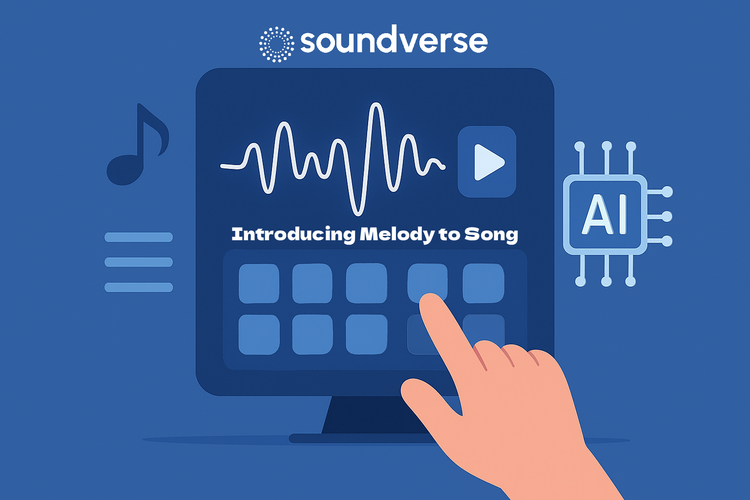Suno & Udio Face Copyright Uncertainty: Why Creators Should Switch to Soundverse
Contents
- The Copyright Office's Report: A Watershed Moment
- Current Legal Challenges for AI Music Platforms
- The Path Forward: Ethical AI Music Development
- Comparing Approaches in the AI Music Landscape
- How Creators Can Navigate the Changing Landscape
- Tools Designed for Legal Compliance
- The Future of AI Music Generation
- Conclusion
- Join Us
The Copyright Office's Report: A Watershed Moment
The latest installment in the Copyright Office's examination of AI represents a critical development in how artificial intelligence intersects with copyright law. While acknowledging AI's transformative potential, the report introduces several concepts that could challenge current business models:
Market Dilution Theory Gains Official Recognition
Perhaps the most significant development is the report's endorsement of what industry observers call the "market dilution theory." This framework suggests that AI-generated content flooding creative markets can harm human creators by diluting royalty pools on streaming platforms, saturating genre-specific marketplaces, and reducing discovery opportunities for human artists.
This represents a departure from traditional copyright analysis, which typically requires direct copying or derivation. Under market dilution theory, harm could be established even when AI outputs don't directly copy specific works.
"Pirated Datasets" Now Explicitly Problematic
The report takes a firm stance on the use of unauthorized or unlicensed content for training AI models:
"Knowing use of pirated datasets should weigh against fair use... Copyright owners have a right to control access."
This position directly challenges the practices of some AI music platforms that have reportedly trained on scraped music data without explicit licensing agreements.
Style Mimicry Under Increased Scrutiny
The report specifically addresses tools that allow users to create outputs mimicking distinctive artistic styles:
"Stylistic imitation may impact creators' markets even without direct infringement."
This could affect platforms offering prompts like "Create a song in the style of [Artist]" or "Make music that sounds like [Band]," especially when these features lack robust safeguards against creating market substitutes.
Factor 4 Dominance in Fair Use Analysis
Legal experts have noted the report's emphasis on the fourth factor of fair use analysis—market harm—potentially elevating its importance over transformative use:
"AI's scale and speed could cause unprecedented market damage."
This shift could influence how courts evaluate AI cases going forward, with greater weight given to potential market impacts rather than technical aspects of how AI systems function.
Current Legal Challenges for AI Music Platforms
The report arrives amid growing legal scrutiny for AI music generators. Major music companies have filed lawsuits against several platforms, alleging copyright infringement through unauthorized use of protected works in training data.
Suno and Udio: Legal Vulnerabilities Exposed
Popular AI music generators face several specific challenges under the new framework:
Training Data Concerns
Both companies have faced allegations regarding their training methodology. Critics argue these platforms may have utilized copyrighted music without proper licensing, which the Copyright Office report now explicitly identifies as problematic for fair use claims.
Output Guardrail Limitations
Current implementations of these platforms allow for style mimicry that could potentially substitute for original artists' works. Examples include:
- The ability to generate tracks that closely mimic distinctive vocal styles
- Features that create instrumental arrangements reminiscent of specific artists
- Tools that replicate genre-specific production techniques associated with particular creators
Market Saturation Risks
The sheer volume of AI-generated content these platforms enable raises concerns under the market dilution theory. With users able to generate unlimited tracks, the potential flooding of distribution platforms represents precisely the scenario the Copyright Office warns against.
The Path Forward: Ethical AI Music Development

As the legal landscape evolves, platforms that have prioritized ethical approaches to AI music generation may be better positioned to weather these changes. Several principles appear to align with the Copyright Office's guidance:
1. Transparent Training Data Practices
Platforms using exclusively licensed or properly cleared materials for AI training demonstrate compliance with the report's emphasis on authorized data usage.
Soundverse, for example, trains its AI models "exclusively on licensed or copyright-free datasets," according to its documentation, potentially avoiding the "pirated dataset" concerns raised in the report.
2. Human-AI Collaboration Over Replacement
Systems designed to augment human creativity rather than replace it may fare better under scrutiny. The Copyright Office has previously indicated that works showing "meaningful human contribution" can qualify for copyright protection.
Tools that enable creators to:
- Add original vocals to AI-generated instrumentals
- Modify AI-suggested arrangements
- Use AI for specific creative elements rather than entire compositions
may align better with copyright principles than fully automated generation.
3. Style Guidance Without Mimicry
Platforms that help users achieve certain genre characteristics without specifically imitating identifiable artists demonstrate awareness of the stylistic imitation concerns raised in the report.
Rather than "Create a song like [Artist]," more ethically positioned prompts might include creating upbeat pop instrumentation, generating harmonies for original vocals, or suggesting chord progressions for specific genres—all without direct artist imitation.
4. Clear Licensing and Usage Rights
Transparent licensing models that clearly communicate what users can and cannot do with AI-generated content help mitigate legal risks. Tiered approaches that differentiate between personal, commercial, and high-profile usage can address varying risk levels.
According to its documentation, Soundverse offers "clear, tiered licensing models" including royalty-free options for content creators and full ownership rights for enterprise users, providing clarity that could help navigate the concerns raised in the report.
Comparing Approaches in the AI Music Landscape
Different AI music platforms have adopted varying strategies toward copyright compliance. As the legal framework evolves, these differences may become increasingly significant.
Training Data Transparency
When it comes to training data sourcing, approaches vary widely across the industry. Platforms using licensed datasets with transparent sourcing demonstrate strong alignment with the Copyright Office's "authorized access" principle. Similarly, those developing proprietary voice models in-house potentially reduce infringement risks.
In contrast, platforms with undisclosed training methods may face increased scrutiny under the new framework. Most concerning under the report's guidance are approaches relying on scraped web content without licensing agreements, as these are directly challenged by the report's stance on "pirated datasets."
Output Control Mechanisms
The degree of control platforms exercise over their outputs also affects alignment with the report's guidance. Tools requiring substantial human input are better positioned under the "meaningful human contribution" standard established for copyright protection. Similarly, systems offering controlled generation with style guidelines may avoid "market substitution" concerns.
More vulnerable under the market dilution theory are platforms providing open-ended generation with minimal restrictions. Most directly challenged by the report are features enabling explicit artist mimicry, which conflict with the warnings on stylistic imitation.
How Creators Can Navigate the Changing Landscape
For musicians, producers, and content creators using AI music tools, the evolving legal framework suggests several best practices:
Document Your Creative Process
Maintaining records of your creative inputs when using AI tools could become increasingly important, particularly for establishing copyright eligibility. Consider saving drafts showing progressive human modifications, documenting original elements you contributed, and keeping records of prompts and generation parameters.
Understand Platform Licensing
Before incorporating AI-generated elements into your work, carefully review the licensing terms of the platform you're using. Understand what rights you have to the outputs, whether there are limitations on commercial usage, and if the platform retains any rights to your creations.
Consider the Intended Use
Higher-profile or commercial applications may warrant greater caution. Personal projects generally carry lower risk, while commercial releases may require more rigorous vetting. High-visibility applications like advertising campaigns may demand the most stringent compliance measures.
Tools Designed for Legal Compliance
Some platforms have developed specific features aimed at addressing legal concerns in AI music generation:
Reference-Based Generation Without Copying
Tools like Soundverse's Similar Song Generator are designed to capture inspiration from reference tracks while avoiding melody replication. This approach aims to create "vibe twins" that evoke similar feelings without copying copyrighted elements.
Stem Isolation for Legal Remixing
Technologies like Splitter AI allow creators to isolate components of existing works for inspiration without directly copying protected material. This can enable legal transformative uses while respecting original copyrights.
Human-AI Collaboration Frameworks
Platforms emphasizing collaboration over automation, such as those requiring human vocal performances or arrangement decisions, may better align with the "meaningful human contribution" standard established for copyright protection of AI-assisted works.
The Future of AI Music Generation
The Copyright Office report suggests that the future of AI music likely lies in responsible development that respects creator rights while still enabling innovation.
Potential Industry Developments
As the legal framework solidifies, we may see:
- More opt-in models where artists explicitly license their works for AI training
- Greater transparency in how AI music systems are developed
- Increased focus on tools that augment human creativity rather than replace it
- Development of industry standards for ethical AI training and deployment
Balancing Innovation and Protection
The challenge for the industry will be finding the right balance between:
- Enabling new creative possibilities through AI
- Protecting the livelihoods and rights of human creators
- Developing sustainable business models for AI music platforms
- Providing clear guidance for users of these technologies
Conclusion
The Copyright Office's report marks a significant moment in the evolution of AI music generation. By endorsing market dilution theory, elevating concerns about unauthorized datasets, and highlighting the risks of style mimicry, it establishes new parameters that could reshape the industry.
Platforms that have prioritized ethical approaches—through licensed training data, human-AI collaboration, controlled outputs, and transparent licensing—appear better positioned to navigate this changing landscape. Meanwhile, creators would be wise to exercise caution, understand the tools they're using, and stay informed about evolving legal standards.
As AI music continues to develop, the most sustainable path forward likely involves technologies that enhance human creativity rather than replace it, supported by business models that fairly compensate both the creators of original works and the developers of innovative tools.
For more information on ethical AI music generation, explore these resources:
- Soundverse's Ethical AI & Licensing Model
- Copyright-Safe Similar Song Generator
- Royalty-Free vs. Copyright-Free Guide
- U.S. Copyright Office's AI Reports
Join Us
Ready to take your creative process into the future? Sign up today at www.soundverse.ai and join our thriving community of creators. Need help getting started? Explore our YouTube playlist for 10 quick lessons on mastering Soundverse: Watch Here.
For enterprises and businesses, Soundverse is ready to partner with you. With our Enterprise Tier, you gain access to exclusive features, including licenses to sync your projects seamlessly. Email us at sales@soundverse.ai to learn more about how we can enhance your creative vision.
Visit Soundverse Pricing to discover which tier best fits your needs, and take the first step toward transforming the way you create music. Let’s shape the future of sound together.
Click below to start your free signup journey and experience the future of music creation:







